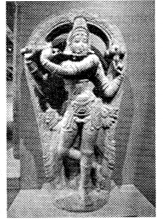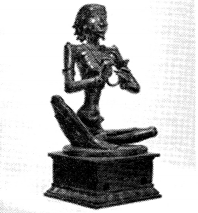Do you need some help in preparing for your upcoming Class 12 History exam? We’ve compiled a list of MCQ questions on Bhakti-Sufi Traditions Class 12 MCQs Questions with Answers to get you started with the subject. You can download NCERT MCQ Questions for Class 12 History Chapter 6 Bhakti-Sufi Traditions: Changes in Religious Beliefs and Devotional Texts with Answers Pdf free download, and learn how smart students prepare well ahead MCQ Questions for Class 12 History with Answers. Start your preparation with MCQ on Bhakti-Sufi Traditions Class 12 Objective Questions.
Bhakti-Sufi Traditions Class 12 MCQs Questions with Answers
Question 1.
What is shari’a?
(a) Muslim Sufi saints
(b) Fasting during the month of Ramzan
(c) Laws governing the Muslim community
(d) Giving alms
Answer
Answer: (c) Laws governing the Muslim community
Question 2.
Who is Ulama?
(a) Devotees of Shiva
(b) Devotees of Vishnu
(c) Muslim Sufi saints
(d) Scholars of Islamic studies
Answer
Answer: (d) Scholars of Islamic studies
Question 3.
What are the devotees of Vishnu called?
(a) Alvars
(b) Nayanars
(c) Lingayats
(d) Chishti
Answer
Answer: (a) Alvars
Question 4.
Which of the following statements is incorrect regarding Karaikkal Ammaiyar?
(a) She was a devotee of Shiva.
(b) She adopted the path of extreme asceticism.
(c) Her compositions were preserved within the Alvar traditions.
(d) Her compositions posed a challenge to patriarchal norms.
Answer
Answer: (c) Her compositions were preserved within the Alvar traditions.
Question 5.
Jangama or wandering monks belonged to which community?
(a) Alvars
(b) Lingayats
(c) Kabirpanthis
(d) Jogis
Answer
Answer: (b) Lingayats
Question 6.
Which general term was used to refer to the migrant communities?
(a) Shakas
(b) Yavanas
(c) Turks
(d) Mlechchha
Answer
Answer: (d) Mlechchha
Question 7.
What is the literal meaning of the term ‘silsila’?
(a) A chain
(b) Disciple
(c) Devotion
(d) Without attributes
Answer
Answer: (a) A chain
Question 8.
Which of the following practices in Chishti Khanqah represent attempts to assimilate local traditions?
(i) Bowing before the Shaikh
(ii) Offering water to the visitors
(iii) Shaving the heads of the initiates
(iv) Yogic exercises
(a) ‘i’ and ‘ii’
(b) only ‘i’
(c) ‘iii’ and ‘iv’
(d) All of the above
Answer
Answer: (d) All of the above
Question 9.
Who composed the prem-akhyan ‘Padmavat’?
(a) Amir Khusrau
(b) Baba Farid
(c) Malik Muhammad Jayasi
(d) Ratansen
Answer
Answer: (c) Malik Muhammad Jayasi
Question 10.
Which of the following statements regarding Sant Kabir is incorrect?
(a) Kabir used terms drawn from Vedantic traditions.
(b) Kabir described the Ultimate reality as Allah, Khuda, Hazrat and Pir.
(c) Many of his compositions are found in Adi Granth Sahib.
(d) Verses attributed to Kabir mention the name of his teacher, Ramanand.
Answer
Answer: (d) Verses attributed to Kabir mention the name of his teacher, Ramanand.
Question 11.
Who led the new religious movement in Karnataka?
Answer
Answer: The new religious movement in Karnataka was led by Basavana a Brahman.
Question 12.
Name the two women poet-saints of Tamil Nadu.
Answer
Answer: Andal and Karaikkal
Question 13.
Match the following.
| (i) Nirguna | (a) sound |
| (ii) Alakh | (b) with attributes |
| (iii) Shabda | (c) the unseen |
| (iv) Sasuna | (d) without attributes |
Choose the correct option
(a) i – d, ii – c, iii – a, iv – b
(b) i – c, ii – a, iii – b, iv – d
(c) i – c, ii – b, iii – a, iv – d
(d) i – d, ii – a, iii – b, iv – c
Answer
Answer: (a) i – d, ii – c, iii – a, iv – b
Question 14.
Given below are two statements, one labelled as Assertion (A) and the other labelled as Reason (R):
Assertion (A): Lingayats did not practice funerary rites such as cremation, prescribed in the Dharmashastras.
Reason (R): Lingayats believe that on death the devotee will be united with Shiva and will not return to this world.
(a) Both (A) and (R) are correct and (R) is the correct explanation of (A).
(b) Both (A) and (R) are correct and (R) is not the correct explanation of (A).
(c) (A) is correct but (R) is not correct.
(d) (R) is correct but (A) is not correct.
Answer
Answer: (a) Both (A) and (R) are correct and (R) is the correct explanation of (A).
Question 15.
Consider the following statements regarding Kabir.
(i) Kabir organised his followers into a community and set up rules for congregational worship.
(ii) Kabir described the Ultimate Reality using terms drawn from Islam, Vedantic traditions and from yogic traditions.
(iii) Verses ascribed to Kabir have been compiled in three distinct but overlapping traditions.
Which of the following statements is/are incorrect?
(a) I and II
(b) II and III
(c) III only
(d) I only
Answer
Answer: (d) I only
Question 16.
Given below are two statements, one labelled as Assertion (A) and the other labelled as Reason (R):
Assertion (A): Pilgrimage, called ziyarat, to tombs of Sufi saints is prevalent all over the Muslim world.
Reason (R): The khanqah was the centre of social life.
(a) Both (A) and (R) are correct and (R) is the correct explanation of (A).
(b) Both (A) and (R) are correct and (R) is not the correct explanation of (A).
(c) (A) is correct but (R) is not correct.
(d) (R) is correct but (A) is not correct.
Answer
Answer: (b) Both (A) and (R) are correct and (R) is not the correct explanation of (A).
Question 17.
Identify the image and write its name.

Answer
Answer: It is a fifteenth-century stone sculpture depicting Krishna playing the flute.
Question 18.
Identify the image and write its name.

Answer
Answer: It is a twelfth-century bronze image of Karaikkal Ammaiyar.
Question 19.
Which of the following statements is NOT correct about Baba Guru Nanak?
(a) Guru Nanak advocated a form of nirguna bhakti.
(b) Baba Guru Nanak organised his followers into a community.
(c) He rejected sacrifices, ritual baths, image worship, austerities, and the scriptures of both Hindus and Muslims.
(d) Guru Nanak appointed one of his disciples, Arjan, to succeed him as the preceptor (guru).
Answer
Answer: (d) Guru Nanak appointed one of his disciples, Arjan, to succeed him as the preceptor (guru).
Question 20.
________ is the best-known woman poet within the bhakti tradition.
Answer
Answer: Mirabai
Question 21.
In the late fifteenth century, _______ emerged as one of the leading proponents of Vaishnavism in Assam.
Answer
Answer: Shankaradeva
Question 22.
Find out from the following pairs which one is correctly matched:
(a) Deg : Food
(b) Khanqah : Pilgrimage
(c) Futuh : Charity
(d) Murids : Master
Answer
Answer: (c) Futuh : Charity
We hope you found this CBSE Class 12 History Bhakti-Sufi Traditions MCQs Multiple Choice Questions with Answers helpful. If you have any questions about NCERT MCQ Questions for Class 12 History Chapter 6 Bhakti-Sufi Traditions: Changes in Religious Beliefs and Devotional Texts with Answers Pdf free download, please share them in the comment box below and we will get back to you at the earliest possible time.